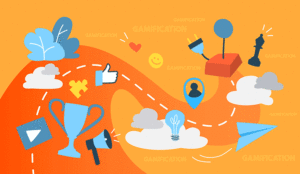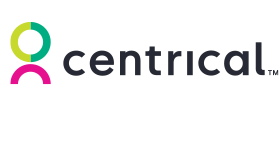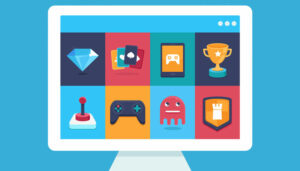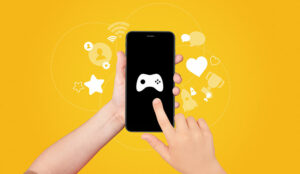Gamification is becoming an increasingly hot buzzword. Organizations across types and industries, from schools to enterprises, are gamifying experiences for students, customers, and employees. But what does it all mean?
Gamification isn’t just a buzzword – it is a solid strategy design to motivate, engage, and drive behaviors – which could be anything from encouraging learning to buying more shoes or coffee, to meeting business KPIs. In this article, we’ll dive into the basics of gamification, how it applies to contexts such as business, education, and other fields, real-life examples of gamification, and some key takeaways.
What Is Gamification?
Gamification is the application of game design elements and principles in non-game contexts to improve engagement, motivation, learning, or problem-solving by incorporating aspects like points, levels, challenges, rewards, and competition to make activities more enjoyable and encourage desired behaviors.
Gamification can be applied in various fields, such as education, marketing, employee onboarding and training, customer loyalty programs, and personal and professional development.
The main goal of gamification is to make a mundane or routine task more appealing and engaging, leading to better outcomes and user experiences.
What Is Gamification in Business?
Gamification in business is essentially what you read above, where game design elements and principles are incorporated into various aspects of a company’s operations to drive motivation, engagement, and productivity.
By incorporating gamification elements, businesses can make tasks more enjoyable and appealing for employees and customers alike. Some common applications of gamification in business include:
Employee Training and Development
Gamification can be used to make training programs more engaging, leading to better knowledge retention and accelerated skill acquisition.
Performance Management
Incorporating game mechanics like points, leaderboards, and badges, companies can create friendly employee competition, while boosting productivity and encouraging desired behaviors.
Customer Engagement
Businesses can use gamification as part of their marketing campaigns, loyalty programs, or customer support to improve customer satisfaction and increase brand loyalty.
Innovation and Problem-Solving
Gamification can help facilitate ideation, collaboration, and problem-solving by fostering an environment of friendly competition and engagement.
Sales
Sales teams can use gamification to create competitions and challenges, motivating team members to achieve their targets and improve their performance.
Onboarding
Gamification can make the onboarding process for new employees more engaging, helping them quickly acclimate to their role while learning about company culture, processes, and tools.
Overall, gamification in business can lead to better outcomes, increased motivation, and improved employee and customer experiences.
What Is Gamification in Education?
Gamification in education refers to the incorporation of game design elements and principles into learning activities, environments, and systems to increase student engagement, motivation, and achievement.
By introducing gamification aspects, educators can make the learning process more enjoyable, interactive, and appealing for students.
Gamification in education can take various forms, such as:
Classroom Activities
Teachers can introduce game elements to classroom activities or lessons, promoting friendly competition, collaboration, and active participation among students.
Digital Learning Platforms
Online educational platforms and apps often integrate gamification features, offering badges, points, or progress indicators as students complete tasks, quizzes, or modules, which helps maintain motivation and interest.
Assessment and Feedback
Gamification can be applied to assessment and feedback systems, providing students with immediate, constructive feedback on their performance and encouraging improvement through rewards and incentives.
Curriculum Design
Educators can develop curricula that incorporate game mechanics, creating a more engaging and immersive learning experience for students.
Skill Development
Gamification can be used to teach and reinforce specific skills or concepts through interactive, game-based activities that allow students to practice and reinforce their learning in a fun and engaging manner.
Overall, gamification in education creates a more enjoyable and motivating learning environment, which can lead to improved knowledge retention, skill acquisition, and academic performance.
Gamification Across Different Fields
Gamification has emerged as a powerful tool for driving engagement and motivation across various fields, including business, marketing, sales, and learning.
By incorporating game design elements and principles into traditionally non-gaming contexts, companies are able to tap into human intrinsic motivations, making activities more enjoyable and compelling.
In the business world, gamification enhances employee training, performance management, and innovation, while marketing professionals leverage gamified strategies to boost customer engagement and brand loyalty.
Sales teams benefit from gamification by fostering friendly competition and improving target achievement, while the learning sector experiences increased knowledge retention and skill acquisition through interactive, game-based experiences.
As a versatile and effective approach, gamification continues to revolutionize the way organizations engage, motivate, and retain both employees and customers.
Gamification Strategies
Gamification strategies have become increasingly popular as organizations seek innovative ways to engage and motivate users in various contexts.
By integrating game design elements, gamification strategies transform mundane tasks into engaging experiences that foster intrinsic motivation and encourage desired behaviors.
These strategies can be applied across diverse sectors, including employee training, marketing campaigns, customer loyalty programs, and educational platforms.
By leveraging the power of gamification, businesses and institutions can achieve higher levels of user engagement, satisfaction, and performance. As gamification strategies continue to evolve, they offer a promising approach to enhancing productivity, collaboration, and learning in the digital age.
5 Different Real-Life Examples of Effective Gamification:
Duolingo
Duolingo is a language learning platform that utilizes gamification to make the process of learning a new language more enjoyable and engaging.
Users earn points, level up, and compete with friends, all while working through progressively challenging language exercises. The app also features streaks and daily goals, encouraging consistent practice and commitment.
Nike+ Run Club
This fitness app combines gamification and social features to motivate users to achieve their running goals.
Users can set targets, track their progress, participate in challenges, earn badges, and share their achievements with friends. The app creates a sense of community, motivation, and competition, making running more fun and engaging.
Starbucks Rewards
Starbucks’ loyalty program incorporates gamification elements to encourage customer engagement and repeat business.
Customers earn stars for every purchase, which can be redeemed for free drinks, food, or merchandise. The program also features tiers, personalized offers, and limited-time challenges, incentivizing customers to make more frequent visits and engage with the brand.
Codecademy
Codecademy is an online learning platform that teaches coding through interactive lessons and hands-on projects. The platform uses gamification by awarding points, badges, and progress indicators as users complete lessons and modules.
This approach helps learners stay motivated and engaged, making the process of learning to code more enjoyable and accessible.
Headspace
Headspace is a meditation and mindfulness app that employs gamification to encourage users to develop a consistent meditation practice. The app tracks users’ meditation streaks, offers badges for completing specific milestones, and provides access to additional content based on their progress.
These gamification elements help users stay motivated and engaged with their mindfulness practice, leading to improved mental well-being.
Summary
Gamification is a powerful approach that incorporates game design elements and principles into non-gaming contexts, aiming to increase user engagement, motivation, and desired behaviors. Below are a few takeaways:
Gamification can be applied across various fields such as business, marketing, sales, and learning, and has revolutionized the way organizations interact with employees and customers alike.
By tapping into intrinsic human motivations, gamification fosters a sense of progress, accomplishment, and enjoyment in activities that might otherwise be considered tedious or mundane.
As a versatile and effective tool, gamification delivers value by enhancing productivity, collaboration, and learning, ultimately contributing to better outcomes and experiences in diverse sectors.
This blog post has been re-published by kind permission of Centrical – View the Original Article
For more information about Centrical - visit the Centrical Website
Call Centre Helper is not responsible for the content of these guest blog posts. The opinions expressed in this article are those of the author, and do not necessarily reflect those of Call Centre Helper.
Author: Centrical
Published On: 5th Jun 2023
Read more about - Guest Blogs, Centrical






 Centrical provides a real-time performance management, microlearning, gamification, coaching, and voice of the employee platform for frontline teams. The solution inspires and personally guides employee success and growth by making every moment actionable.
Centrical provides a real-time performance management, microlearning, gamification, coaching, and voice of the employee platform for frontline teams. The solution inspires and personally guides employee success and growth by making every moment actionable. 






























